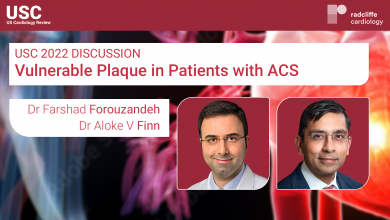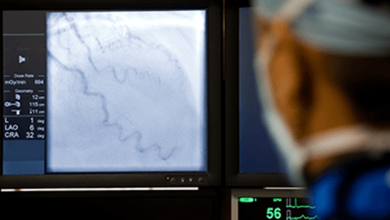Search results
Author(s):
Farshad Forouzandeh
,
Aloke V Finn
Added:
2 years ago
In this insightful discussion, Dr Aloke V Finn (CVPath Institute & University of Maryland, Baltimore, MD, US) and Dr Farshad Forouzandeh (Case Western Reserve University Cleveland, Cleveland, OH, US) discuss key questions relating to vulnerable plaque in patients with acute coronary syndrome:
How has intravascular imaging improved our understanding of vulnerable plaques, and in which direction…
View more
Author(s):
Atsushi Sakamoto
,
Anne Cornelissen
,
Yu Sato
,
et al
Added:
2 years ago
Filippo Crea
Author
Renu Virmani
Research Area(s) / Expertise:
Job title: President and Medical Director
Author
Author(s):
David Morrow
Added:
3 years ago
Risk stratification of patients with an acute coronary syndrome (ACS) starts on presentation and is a continuous process to predict those who are at high risk for further ischemic events or adverse outcomes. Among patients with non-ST-elevation myocardial infarction (NSTEMI), risk stratification begins with initial assessment to detect patients at immediate high risk. Subsequent evaluation is…
View more
Author(s):
Xiao-Fei Gao
,
Xiang-Quan Kong
,
Guang-Feng Zuo
,
et al
Added:
3 years ago
Coronary angiography is widely used to diagnose coronary artery disease and to guide percutaneous coronary intervention (PCI). However, 2D projection angiography cannot completely reflect the 3D coronary lumen, with several inherent limitations in evaluating plaque composition, vessel diameter, diffuse reference vessel disease, lesion severity, as well as the result of stent deployment. In the…
View more
Author(s):
Christopher M Kramer
Added:
3 years ago
Atherosclerosis is a systemic disease that can silently affect the entire vascular system and often manifests clinically as stroke, myocardial infarction or sudden cardiac death. Despite advances in diagnosis and treatment, the sequelae of atherosclerosis remain the leading cause of death in adult Americans. Traditionally the gold standard for the diagnosis and assessment of atherosclerosis…
View more
Author(s):
Annapoorna Kini
Added:
1 year ago
ACC.23/WCC — Principle investigator of YELLOW III, Dr Annapoorna Subhash Kini(Mount Sinai Hospital, US) joins us to talk about the study that assessed the effect of evolocumab (Repatha) on coronary plaque morphology using intravascular imaging and gene expression analysis of peripheral blood mononuclear cells (PBMC) in 140 patients with stable CAD on maximally tolerated statin therapy …
View more
Author(s):
Wolfgang Koenig
,
Natalie Khuseyinova
Added:
3 years ago
Atherosclerosis is characterized by a non-specific local inflammatory process accompanied by a systemic response. A number of prospective studies in initially healthy subjects and in patients with manifest atherosclerosis have now convincingly demonstrated a strong and independent association between even slightly elevated concentrations of various systemic markers of inflammation and a number of…
View more
Author(s):
George A Beller
Added:
3 years ago
A significant amount of data has accumulated over the past 20 years, demonstrating the value of exercise or pharmacologic stress non-invasive cardiovascular imaging techniques for the diagnostic and prognostic assessment of patients with suspected or known cardiovascular disease.1-8 Stress can be induced by either multistage exercise testing that is symptom-limited or by pharmacologic means with…
View more















